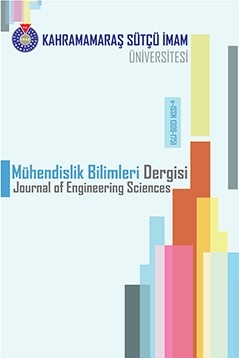Synthesis and characterization of ruthenium (II) complexes with new Schiff base ligand from the reaction of 4-(aminomethyl)phenol with picolinaldehyde
N,N donor atomlu Schiff bazı ligandı ve onun rutenyum (II) kompleksi sentezlenmiştir. Ligand ve kompleksin yapıları IR, UV-Visible spektroskopisi, 1H ve 13C NMR spektroskopisi, elementel analiz magnetik süssebtibilite yöntemleri ile karakterize edilmiştir. Analitik veriler kompleks yapısında metal ligand oranının 1:1 olduğunu göstermiştir
Anahtar Kelimeler:
Schiff bazı, Ru(II) kompleksleri, karakterizasyon
Synthesis and characterization of ruthenium (II) complexes with new Schiff base ligand from the reaction of 4-(aminomethyl)phenol with picolinaldehyde
The Schiff base ligand containing N,N donor atoms, (E)-4-(((pyridin-2-ylmethylene)amino)methyl)phenol (L1H) (Fig. 1), and its Ru(II) complex have been prepared. The ligand and its complex have been characterized by elemental analyses, IR spectra, UV-Visible spectroscopy, 1H and 13C NMR spectra and magnetic susceptibility measurements. The analytical data show that the metal to ligand ratio in the L1H complexes is 1:1.
Keywords:
Schiff Base; Ru(II) complexes, characterization.,
___
- Ispir E. The synthesis, characterization, electrochemical character, catalytic and antimicrobial activity of novel, azo-containing Schiff bases and their metal complexes. Dyes Pigments. 2009; 82(1):13-9.
- Atabey, H., Findik, E., Sari, H., Ceylan, M., “Comparison of chelating ability of NO-, NS-, ONS-, and ONO-type Schiff base derivatives and their stability constants of Bis-complexes with copper(II)”, Turk J Chem., 2014, 38(1), 109.
- Huang, D. X., Wang, C. X., Song, Y. B., “Immobilized complexes of the salen Schiff's base with metal as oxidation catalysts”, Russ J Gen Chem., 2013, 83(12), 2361.
- Khandar. A. A.; Nejati, K. Synthesis And Characterization of a Series of Copper(II) Complexes With Azo-linked Salicylaldimine Schiff Base Ligands. Crystal Structure of Cu5PHAZOSALTN.
- CHCl3. Polyhedron. 2000, 19, 607-613.
- Tümer, M.; Çelik, C.; Köksal, H.; and Serin, S. Transition Metal Complexes of Bidentate Schiff Base Ligands. Trans. Met. Chem. 1999, 24, 525.
- J.L. Pratihar, S. Bhaduri, P. Pattanayak, D. Patra, S. Chattopadhyay, Reactions of 2-(arylazo)aniline with ruthenium substrates: Isolation, characterizations and reactivities of delocalized diazoketiminato and orthometallated Ru(II) chelates, J Organomet Chem, 2009, 694,3401- 3408.
- R.N. Prabhu, R. Ramesh, Synthesis, structural characterization, electrochemistry and catalytic transfer hydrogenation of ruthenium(II) carbonyl complexes containing tridentate benzoylhydrazone ligands, J Organomet Chem, 2012, 718, 43-51.
- R.K. Rath, M. Nethaji, A.R. Chakravarty, Synthesis, crystal structure and catalytic properties of (p-cymene)ruthenium(II) azophenol complexes: azophenyl to azophenol conversion by oxygen insertion to a ruthenium carbon bond, J Organomet Chem, 2001, 633, 79-84.
- R.K. Rath, M. Nethaji, A.R. Chakravarty, Transfer hydrogenation of acetophenone promoted by (arene)ruthenium(II) reduced Schiff base complexes: an X-ray structure of [(η6-p- cymene)RuCl(OC6H4-2-CH2NHC6H4-p-Me)], Polyhedron, 2001, 20, 2735-2739.
- Sanmartin, J.; Bermejo,M. R.; Gariç-Deibe, A. M.; Maneiro, M.; Large, C.; Costa-Filho, A. J. Mono- and Polynuclear Complexes of Fe(II), Co(II), Ni(II), Cu(II), Zn(II) and Cd(II) with N,N-Bis(3- hydroxysalicylidene)-1,3-diamino-2-propanol. Polyhedron, 2000, 19, 185-192.
- Jaworska, J. K. New Platinum(II) Complexes With Schiff Base Ligands. Trans. Met. Chem., 1994, 19, 296-298.
- Tümer, M.; Köksal, H.; Serin, S. Synthesis, Characterization and Thermal Investigation of some Metal Complexes Derived from New Schiff Base Ligands. Synth. React. Inorg. Met.-Org. Chem., 1998, 28 (8), 1393-1404.
- Zolezzi, S.; Decinti, A.; Spodine, E. Sythesis and Characterization of Copper(II) Complexes with Schiff Base Ligands Derived from Ethylenediamine, Diphenylethylenediamine and Nitro, Bromo and Methox Saliclaldehyde. Polyhedron. 1999, 18, 897-904.
- Başlangıç: 1998
- Yayıncı: Kahramanmaraş Sütçü İmam Üniversitesi
Sayıdaki Diğer Makaleler
Emre GEMCİ, Sümeyye AKARSU, C.Ayhan ZIBA, Mustafa DOLAZ
Sabit Isı Akısı Altında İzotermal Olmayan Kanal Akışında Nanoakışlar İçin Chebyshev Yaklaşımı
Coşkun ÖZALP, Betül TEYMUR, Bülent YANIKTEPE, Muharrem İMAL
Beş Kademeli Modifiye Bardenpho Prosesi ile Atıksulardan Azot ve Fosfor Giderimi
Yağmur UYSAL, Berkin ÜSTÜNYILDIZ
Kılavuzlu Barajı Sulama Kanalında Su Derinliğinin Hec-Ras Programı İle Modellenmesi
Mehmet ÜNSAL, Alişan NALCIOĞLU
Peyniraltı Suyu Arıtımında Tek ve Çift Aşamalı Anaerobik Reaktörün Optimizasyonu
Emre YAZAR, Kevser CIRIK, Şebnem ÖZDEMIR, Dilek AKMAN, Yakup CUCİ, Özer ÇINAR
X-45 Tipi Delta Kanat Modeli Üzerinde Oluşan Akış Karakteristikleri ve Aerodinamiği
